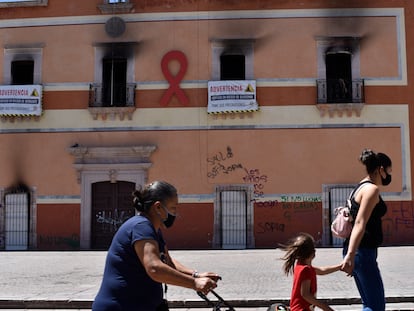Easter in Cancún: did someone say Covid?
Sparklers atop bottles of vodka, revelers on packed dancefloors, drunken crowds in the street and not a mask in sight – welcome to the “sanitary safety bubble zone” for tourists fleeing pandemic restrictions
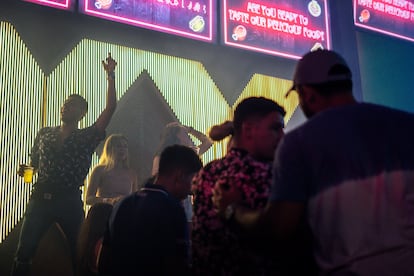
If intelligent life from another planet had visited Cancún during the Easter break it would probably have concluded there wasn’t much hope for us, that the base urges of humankind are more powerful than the dangers of a global pandemic. The need to gather with other people, to mingle sweat in a dingy nightclub, to rub against tequila-fueled strangers on a dancefloor, to shout spittle-flecked orders at a waiter for two more bottles, to live as people lived before 2020, without a mask in sight. For others, health is also measured by being able to put food on the table after a year when tourism has stood still. But this is 2021 and coronavirus has killed almost three million people worldwide. Yet in this corner of the Mexican Caribbean, life is being celebrated as though the deaths beyond do not count. Did someone say Covid?
The portal to this alternate universe is in Kukulcan street, in a part of the tourist zone in Cancún that resembles Las Vegas or a theme park for over-18s. On a neon-bathed corner, with searchlights scouring the night sky, waves of revelers flow past all-night discos thumping out ear-splitting music. A sign has been erected to greet tourists: “Sanitary safety bubble zone.” A team of state government workers carries out quick temperature tests on everyone about to enter one of the nightclubs, where it is impossible not to breathe the air others have breathed, inevitable people will be in close contact, dancing nose to nose, passing the virus between them.
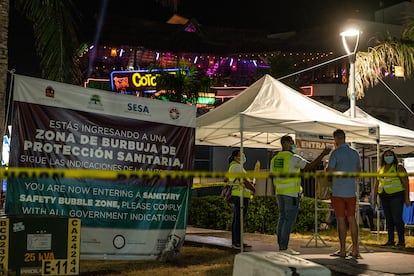
“Hey, this is a proper bender, don’t you think?” a young man in shorts and a skin-tight shirt says to one of the workers after having his temperature taken. Everyone knows what’s happening beyond the heralded “sanitary safety bubble zone,” and all those heading in know what they have come for. The mecca for bachelor parties and American spring breakers advertises in English that this is better than Las Vegas. Clubs such as Coco Bongo or Mandalay are open for new customers and charge entrance fees ranging from $100 (€85) to $5,000 (€4,230) for a VIP table.
To one side of the entry point, a pair of bored healthcare workers stand vigil in case any partygoers decide to take up the offer of a free antigen test. “We’ve only had five people come tonight. But they were locals, they know that we are here and that it’s free and that’s why they come. We haven’t had a single tourist,” they say resignedly. The objectives of preventive healthcare do not mix well with the goals of those crossing this frontier in search of alcohol and good times, in defiance of the pandemic on the other side. A night on the town can be swiftly cut short in the case of a positive test. Then, the hotel in question and the Quintana Roo state government are informed and the patient obliged to quarantine.
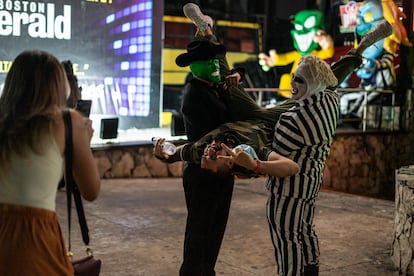
After passing the thin blue line of healthcare professionals, the last sensation one feels is of being protected against the coronavirus. Two men – one dressed as Jim Carrey in The Mask, the other as Michael Keaton in Beetlejuice – chase a tourist and lift him by his legs and shoulders while his girlfriend takes photos. In a club across the street, a waiter picks his way across a packed dancefloor carrying a tray loaded with glasses and a lighted sparkler sticking out of a bottle of vodka. The party is in full swing, hands in the air, hugging and dancing, reggaeton pumping from the sound system.
A little further along the street, in a bar more geared towards rock fans with a live band playing, a waiter prepares a shisha for a table of customers, filling the jar with water and placing fresh charcoal in the bowl on top. Then, he blows through the hose to light it to save his customers the effort of getting it going. But they will smoke it through the same mouthpiece, which has just been used by the waiter and will now be passed around the table. This sanitary detail appears to have escaped everyone.
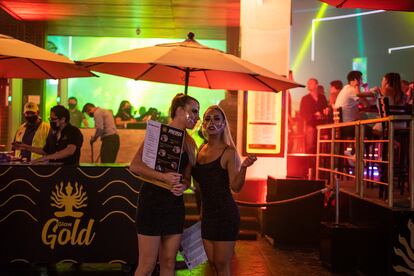
The only people wearing a face mask in this fun-loving corner of Cancún are hotel workers, waiters, bartenders and the women employed to offer tourists discounts for the nightclubs. They wear masks and plastic visors and try to keep the virus at arm’s length, night after night. Few can afford another downturn in an area where livelihoods depend predominantly on tourism: 87% of Quintana Roos’ gross domestic product (GDP) comes from the sector. Hotel occupancy during the Easter vacation was at 70%, according to the Cancún Hoteliers Association. The state government was anticipating 665,000 visitors.
“Put your mask on, please,” a waiter reminds a tourist who had approached him to order food at a beachside restaurant. In Cancún, as in the rest of the Riviera Maya, especially in Tulum, tourists wander about unconcerned by the latent threat of another coronavirus wave in the area and of the potential for carrying the virus home with them, as was the case with 44 Argentinean tourists who boarded their plane without issue in mid-March and tested positive when they landed. When the music stops, the coronavirus always finds a chair.
English version by Rob Train.
Tu suscripción se está usando en otro dispositivo
¿Quieres añadir otro usuario a tu suscripción?
Si continúas leyendo en este dispositivo, no se podrá leer en el otro.
FlechaTu suscripción se está usando en otro dispositivo y solo puedes acceder a EL PAÍS desde un dispositivo a la vez.
Si quieres compartir tu cuenta, cambia tu suscripción a la modalidad Premium, así podrás añadir otro usuario. Cada uno accederá con su propia cuenta de email, lo que os permitirá personalizar vuestra experiencia en EL PAÍS.
¿Tienes una suscripción de empresa? Accede aquí para contratar más cuentas.
En el caso de no saber quién está usando tu cuenta, te recomendamos cambiar tu contraseña aquí.
Si decides continuar compartiendo tu cuenta, este mensaje se mostrará en tu dispositivo y en el de la otra persona que está usando tu cuenta de forma indefinida, afectando a tu experiencia de lectura. Puedes consultar aquí los términos y condiciones de la suscripción digital.


